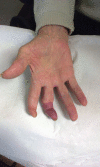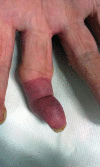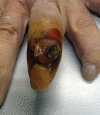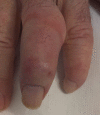Complicated Replanted Finger, 34 Years after Revascularization
- PMID: 33299710
- PMCID: PMC7722617
- DOI: 10.1097/GOX.0000000000003246
Complicated Replanted Finger, 34 Years after Revascularization
Abstract
Merely a few reports of late failure (later than the 7th postoperative day) of a digital replantation can be found in the literature. Discussions of the factors that might cause a late failure are concise. To our knowledge, there are no reports of failure in literature as late as the case we are presenting. An 87-year-old white man was diagnosed with acute complications of a digital replantation, 34 years after initial surgery. Ultrasound examination and an arteriography demonstrated occlusion of the arterial anastomosis. The patient's surgical file revealed scars of former replantation surgery of both the index and the middle finger. In the latter, 1 artery and 2 veins were anastomosed. Considering the age and comorbidities of the patient, revascularization of the finger was not performed. Local wound care and analgesic drugs were prescribed. After initial deterioration and ulceration, gradual improvement was noticed. Total wound healing occurred at 3 months after the initial consultation. Compared with free flap surgery in general, finger replantations are at a higher risk of late complications because digital neovascularization is directly correlated to the contact surface area. This contact surface is usually larger in other free flaps. Furthermore, diseases that deteriorate circulation most likely affect the short- and the long-term survival of a digital replantation. From this point of view, performing both volar digital arterial anastomoses, whenever possible, might reduce early as well as late failure in replantation surgery.
Copyright © 2020 The Authors. Published by Wolters Kluwer Health, Inc. on behalf of The American Society of Plastic Surgeons.
Conflict of interest statement
Figures




Similar articles
-
[Acute vascular disorder as a complication of replantation and revascularization of the digital area].Handchir Mikrochir Plast Chir. 1990 Jan;22(1):39-45. Handchir Mikrochir Plast Chir. 1990. PMID: 2311996 German.
-
Safety and Suitability of Finger Replantations as a Residency Training Procedure: A Retrospective Cohort Study With Analysis of the Initial Postoperative Outcomes.Ann Plast Surg. 2017 Apr;78(4):431-435. doi: 10.1097/SAP.0000000000000945. Ann Plast Surg. 2017. PMID: 27893542
-
The effects of the number and ratio of repaired arteries and veins on the survival rate in digital replantation.Ann Plast Surg. 2000 Mar;44(3):288-94. doi: 10.1097/00000637-200044030-00007. Ann Plast Surg. 2000. PMID: 10735221
-
Sensory recovery following digital replantation.Microsurgery. 1990;11(3):236-42. doi: 10.1002/micr.1920110311. Microsurgery. 1990. PMID: 2215195 Review.
-
Postoperative care in finger replantation: our case-load and review of the literature.Eur Rev Med Pharmacol Sci. 2015;19(14):2552-61. Eur Rev Med Pharmacol Sci. 2015. PMID: 26221881 Review.
References
-
- Acland R. Thrombus formation in microvascular surgery: an experimental study of the effects of surgical trauma. Surgery. 1973;73:766–771. - PubMed
-
- Segreto F, Marangi GF, Signoretti M, et al. The use of botulinum toxin in flap surgery: a review of the literature. Surg Innov. 2019;26:478–484. - PubMed
-
- Cavadas PC, Rubí C, Thione A, et al. Immediate versus overnight-delayed digital replantation: comparative retrospective cohort study of survival outcomes. J Hand Surg Am. 2018;43:625–630. - PubMed
-
- Lee ZH, Klifto CS, Milone MT, et al. Survival after digit replantation and revascularization is not affected by the use of interpositional grafts during arterial repair. Plast Reconstr Surg. 2019;143:551e–557e. - PubMed
Publication types
LinkOut - more resources
Full Text Sources
